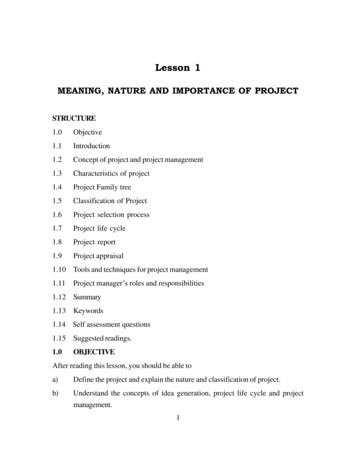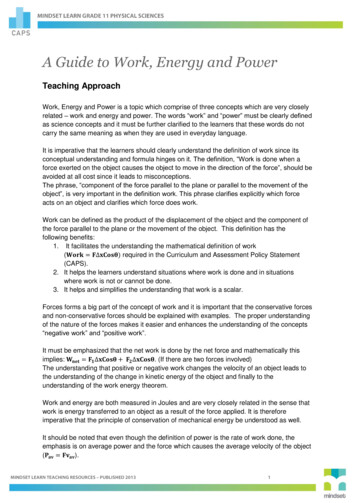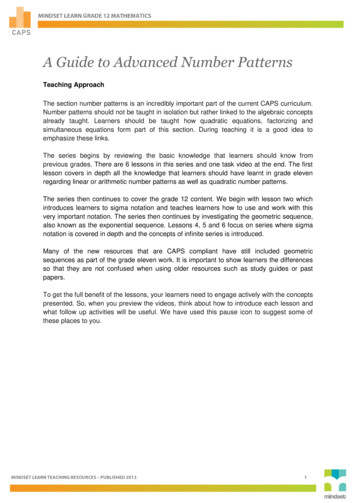
Transcription
Lesson 1MEANING, NATURE AND IMPORTANCE OF ept of project and project management1.3Characteristics of project1.4Project Family tree1.5Classification of Project1.6Project selection process1.7Project life cycle1.8Project report1.9Project appraisal1.10 Tools and techniques for project management1.11Project manager’s roles and responsibilities1.12 Summary1.13 Keywords1.14 Self assessment questions1.15 Suggested readings.1.0OBJECTIVEAfter reading this lesson, you should be able toa)Define the project and explain the nature and classification of project.b)Understand the concepts of idea generation, project life cycle and projectmanagement.1
1.1INTRODUCTIONProjects have a major role to play in the economic development of a country.Since the introduction of planning in our economy, we have been investing large amountof money in projects related to industry, minerals, power, transportation, irrigation,education etc. with a view to improve the socio-economic conditions of the people.These projects are designed with the aim of efficient management, earning adequatereturn to provide for future development with their own resources. But experienceshows that there are several shortcomings in the ultimate success of achieving theobjectives of the proposed project.1.2CONCEPT OF PROJECT AND PROJECT MANAGEMENTThe term project has a wider meaning. A project is accomplished by performing aset of activities. For example, construction of a house is a project. The construction of ahouse consists of many activities like digging of foundation pits, construction offoundation, construction of walls, construction of roof, fixing of doors and windows,fixing of sanitary fitting, wiring etc. Another aspect of project is the non-routine natureof activities. Each project is unique in the sense that the activities of a project are uniqueand non routine. A project consumes resources. The resources required for completinga project are men, material, money and time. Thus, we can define a project as an organizedprogramme of pre determined group of activities that are non-routine in nature and thatmust be completed using the available resources within the given time limit.Let us now consider some definitions of ‘project’. Newman et. al define that “aproject typically has a distinct mission that it is designed to achieve and a cleartermination point the achievement of the mission”.Gillinger defines “project” as the whole complex of activities involved in usingresources to gain benefits. Project management institute, USA defined project as “asystem involving the co-ordination of a number of separate department entitiesthroughout organization, in a way it must be completed with prescribed schedules andtime constraints”.2
According to the encyclopedia of management, “project is an organized unitdedicated to the attainment of goal, the successful completion of a development projecton time, within budget, in conformance with predetermined programme specification.”Though project management is in the process of getting evolved as a separatebranch of study, projects are not new to the earth. One of the seven wonders of theworld, the pyramids date back to 2650 B.C. which stand as the hall mark of Egyptiancivilization. The period of construction of the Taj Mahal, another wonder of the worldis reported to be during 1626-1648 A.D. It is reported that about 20,000 persons workedfor nearly 22 years to complete this spectacular structure, which stands today asmankind’s proudest creation. One can imagine the extent of resources and expertisethat would have been put forth for the completion of such magnificent projects.Project management is an organised venture for managing projects, involvesscientific application of modern tools and techniques in planning, financing,implementing, monitoring, controlling and coordinating unique activities or taskproduce desirable outputs in accordance with the determined objectives with in theconstraints of time and cost.1.3CHARACTERISTICS OF PROJECT(1)Objectives : A project has a set of objectives or a mission. Once theobjectives are achieved the project is treated as completed.(2)Life cycle : A project has a life cycle. The life cycle consists of five stagesi.e. conception stage, definition stage, planning & organising stage,implementation stage and commissioning stage.(3)Uniqueness : Every project is unique and no two projects are similar. Settingup a cement plant and construction of a highway are two different projectshaving unique features.(4)Team Work : Project is a team work and it normally consists of diverseareas. There will be personnel specialized in their respective areas andco-ordination among the diverse areas calls for team work.(5)Complexity : A project is a complex set of activities relating to diverseareas.(6)Risk and uncertainty : Risk and uncertainty go hand in hand with project. Arisk-free, it only means that the element is not apparently visible on thesurface and it will be hidden underneath.3
(7)Customer specific nature : A project is always customer specific. It is thecustomer who decides upon the product to be produced or services to beoffered and hence it is the responsibility of any organization to go forprojects/services that are suited to customer needs.(8)Change : Changes occur through out the life span of a project as a naturaloutcome of many environmental factors. The changes may very from minorchanges, which may have very little impact on the project, to major changeswhich may have a big impact or even may change the very nature of theproject.(9)Optimality : A project is always aimed at optimum utilization of resourcesfor the overall development of the economy.(10)Sub-contracting : A high level of work in a project is done throughcontractors. The more the complexity of the project, the more will be theextent of contracting.(11)Unity in diversity : A project is a complex set of thousands of varieties.The varieties are in terms of technology, equipment and materials, machineryand people, work, culture and others.1.4PROJECT FAMILY TREEA project normally originates from a plan, national plan or corporate plan. Innormal scheme of things, the family tree for a project would be as given belowPlan National/Corporate plan with target for growth.TProgramme health programme, educational programme, R&D programme.TProject Power plant, hospital, housingproject etc.TWork Package Water supply, powersupply and distribution package.T construction & foundation.Task Award of water supply contract,T preparation of drawing.Activity Excavation, laying of cable,Fig. 1.1 Project Family Tree4
1.5CLASSIFICATION OF PROJECTSThe location, type, technology, size, scope and speed are normally the factorswhich determine the effort needed in executing a project. Project can be classifiedunder different heads, some of which are shown in figure 1.2.TYPES OF ialNon-ConventionalR&DMegaGrassHighConventional cementNew ProjectDisasterFig. 1.2 Classification of Project1.6PROJECT SELECTION PROCESSIdentification of a new project is a complex problem. Project selection processstarts with the generation of project ideas. In order to select the most promising project,the entrepreneur needs to generate a few ideas about the possible project one can5
undertake. The project ideas as a process of identification of a project begins with ananalytical survey of the economy (also known as pre-investment surveys). The surveysand studies will give us ideas. The process of project selection consists of followingstages :¾ Idea generation¾ Environment appraisal.¾ Corporate appraisal¾ Scouting for project ideas.¾ Preliminary screening.¾ Project rating index¾ Sources of positive Net Present Value.¾ Entrepreneur qualities.Idea Generation :- Project selection process starts with the generation of a projectidea. Ideas are based on technological breakthroughs and most of the project ideas arevariants of present products or services. To stimulate the flow of ideas, the followingare helpful:SWOT Analysis :- SWOT is an acronym for strengths, weaknesses, opportunities andthreats. SWOT analysis represents conscious, deliberate and systematic effort by anorganisation to identify opportunities that can be profitably exploited by it. PeriodicSWOT analysis facilitates the generation of ideas.Operational objectives of a firm may be one or more of the following. Cost reduction. Productivity improvement. Increase in capacity utilisation. Improvement in contribution margin.6
Fostering a conducive climate :- To tap the creativity of people and to harness theirentrepreneurial skills, a conducive organisation climate has to be fostered. Twoconspicuous examples of organisation which have been exceptionally successful intapping the creativity of employees are the Bell Telephone Laboratory and the 3MCorporation. While the former has succeeded in harnessing creativity by providing anunconstrained environment, the latter has effectively nurtured the entrepreneurial skillsof its employees as sources of idea generation. The project ideas can be generatedfrom various internal and external sources. These are : Knowledge of market, products, and services. Knowledge of potential customer choice. Emerging trends in demand for particular product. Scope for producing substitute product. Market survey & research. Going through Professional magazines. Making visits to trade and exhibitions. Government guidelines & policy. Ideas given by the experienced person. Ideas by own experience. SWOT analysis.Environment appraisal :- An entrepreneur or a firm systematically appraise theenvironment and assess its competitive abilities. For the purposes of monitoring, thebusiness environment may be divided into six broad sectors as shown in fig. no. 1.3.The key elements of the environment are as follow :Economic Sector State of the economy Overall rate of growth7
Cyclical fluctuations Inflation rate Growth rate of primary, secondary and territory sector Growth rate of world economy Trade surplus and deficits Balance of PaymentGovernment Sector Industrial policy Government programmes and projects Tax structure EXIM policy Financing norms Subsidies incentives and concessions Monetary policyTechnological Sector Emergence of new technologies Access to technical know-how, foreign as well as indigenousSocio-demographic Sector Population trends Age shifts in population Income distribution Educational profile Employment of women Attitudes toward consumption and investment8
Competition Sector Number of firms in the industry and the market share of the topfew Degree of homogeneity and differentiation among the products Entry barrier Comparison with substitutes in term of quality and price Marketing polices and practicesSupplier Sector Availability and cost of raw material Availability and cost of energy Availability and cost of entCompetitorSupplierGeographicFig. 1.3 Business EnvironmentCorporate Appraisal :- A realistic appraisal of corporate strengths and weaknessesis essential for identifying investment opportunities which can be profitably exploited.The broad areas of corporate appraisal and the important aspects to be consideredunder them are as follow :Marketing and Distribution Market Image Product Line9
Product Mix Distribution Channels Customer loyalty Marketing & distribution costsProduction and Operations Condition and capacity of plant and machinery Availability of raw material and power Degree of vertical integration Locational advantage Cost structureResearch and Development Research capabilities of the firm Track record of new product developments Laboratories and testing facilities Coordination between research and operationsCorporate Resources and Personnel Corporate image Dynamism of top management Relation with government and regulatory agencies State of industry relationsFinance and Accounting Financial leverage and borrowing capacity Cost of capital Tax structure10
1.7 Relation with share holders and creditors Accounting & control system Cash flow and liquidityPROJECT LIFE CYCLEA project is not a one shot activity. Even a shooting star has a time and life span. Projectlifecycle is spread over a period of time. There is an unavoidable gestation period forthe complex of activities involved to attain the objectives in view. This gestation period,however, varies from project to project but it is possible to describe, in general term,the time phasing of project planning activities common to most projects. The principalstages in the life of a project are : Identification Initial formulation Evaluation (selection or rejection) Final formulation (or selection) Implementation Completion and operationDevelopment projects are expressly designed to solve the varied problems ofthe economics whether in the short or long run. The surveys or in depth studies wouldlocate the problems and the project planner will have to identify the projects that wouldsolve the problems most effectively. At this stage, we are concerned with the kind ofaction and type of project that would be required in rather broad term. In other wordsthe surveys and studies will give us ideas and throw up suggestions which would beworked out in detail later and then evaluated objectively before being accepted forimplementation.What types of surveys and studies are to be undertaken? The current sociopolitical economic situation has to be critically assessed. It will also be necessary toreview it in its historical perspective necessitating the undertaking of a survey of the11
behaviour and growth of the economy during the preceding decades. On the basis ofpast trends, extrapolation may be made of future possible trends and tendencies, shortand long term. The
Project management institute, USA defined project as “a system involving the co-ordination of a number of separate department entities throughout organization, in a way it must be completed with prescribed schedules and time constraints”. 3 According to the encyclopedia of management, “project is an organized unit dedicated to the attainment of goal, the successful completion of a .










